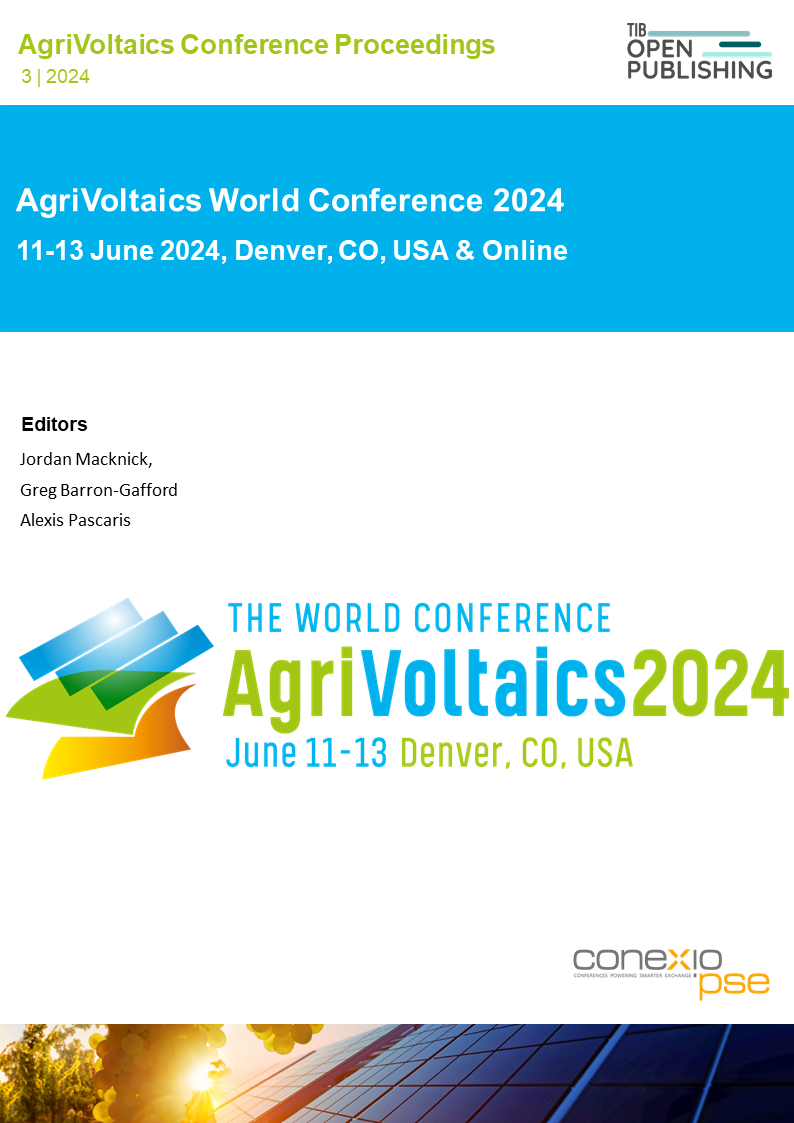Feasibility of AgriVoltaic Wheat Farming with Standard-Height, Utility-Scale Tracking Systems
DOI:
https://doi.org/10.52825/agripv.v3i.1355Keywords:
Wheat Farming, AgriVoltaics, Productivity ComparisonAbstract
This research focuses on AgriVoltaic systems, combining standard-height (1.5 meters) PV arrays with single-axis solar trackers for wheat cultivation. The study was conducted in Sorocaba/São Paulo, at the Nextracker Solar Study Laboratory situated at Flextronics Institute of Technology (FIT). This study reveals that wheat production between PV rows is minimally affected by shading. In the 2023 winter wheat season in Brazil, the production in Regular Agriculture was 12.04 ± 4.27 tons/ha. In the AgriVoltaics area, it produced 10.72 ± 1.52 tons/ha of wheat in addition to 2354.82kWh/kWp-year. In the area dedicated to energy production, it generated a performance of 2462.26kWh/kWp-year. Statistically, using the Tukey’s test, it is possible to state that there is no difference in productivity, although there are differences in morphological and physiological performance, issues that should be better explored in future studies. Furthermore, AgriVoltaics systems observed a 40% reduction in irrigation requirements, making it economically feasible for both energy providers and local farming economies. So, this study demonstrates successful integration of cost-effective PV trackers, offering potential for large-scale co-production of food and renewable energy.
Downloads
References
Expert Market Research (EMR), “Global Buckwheat Market Report and Forecast 2024-2032,” in Agriculture and Farming, https://www.expertmarketresearch.com/reports/buckwheat-market (February 20th, 2025)
United States Department of Agriculture (USDA), “Crop Production Maps,” 2023, https://ipad.fas.usda.gov/ogamaps/cropproductionmaps.aspx (February 20th, 2025)
W. Axel; B. Andrea; H. Jens; Z. Sabine; L. Iris; H. Petra, “Agrivoltaic system impacts on microclimate and yield of different crops within an organic crop rotation in a temperate climate,” in Agronomy for Sustainable Development, 2021, 41:59, doi: https://doi.org/10.1007/s13593-021-00714-y
A. Stefano; Y. Xinyou; C. Michele, “Agrivoltaic systems to optimize land use for electric energy production,” in Applied Energy, 2018, vol.220, pp. 545-561. doi: https://doi.org/10.1016/j.apenergy.2018.03.081
M. Lu. Silvia; Z. Sebastian; B. Stridh; A. Avelin; A. Stefano; C. Michele; E. C. Pietro, “Photosynthetically active radiation decomposition models for agrivoltaic systems applications,” 2022, vol.244, pp. 536-549. doi: https://doi.org/10.1016/j.solener.2022.05.046
S. N. Bhandari; S. Sabine; K. Wilhelm; S. Holger; A. Rabani; B. Ramchandra, “Economic Feasibility of AgriVoltaic Systems in Food-Energy Nexus Context: Modelling and a Case Study in Niger,” in Agronomy, 2021, vol.11, pp. 1-22. doi: https://doi.org/10.3390/agronomy11101906
P. Lisa; W. Axel; B. Andrea; H. Petra; L. Iris; Z. Sabine; S. Andreas, “Agrivoltaics mitigate drought effects in winter wheat,” in Physiologia Plantarum, 2023, vol.175, doi: https://doi.org/10.1111/ppl.14081
Published
How to Cite
Conference Proceedings Volume
Section
License
Copyright (c) 2025 Milena Chanes de Souza, Ricardo Nery de Castro, Benhur Azambuja Possato, Matthias B. Krause, Sol Hutson

This work is licensed under a Creative Commons Attribution 4.0 International License.
Accepted 2025-01-28
Published 2025-05-28
